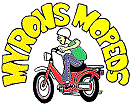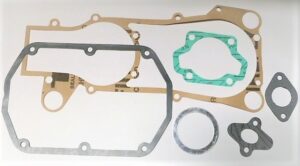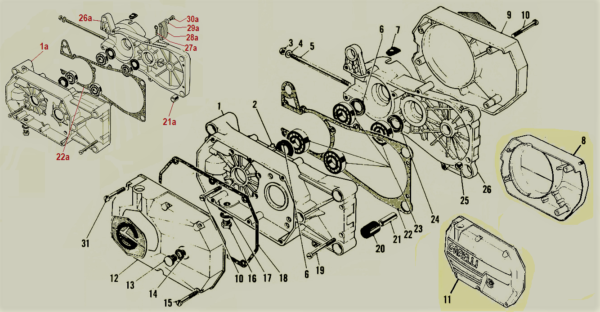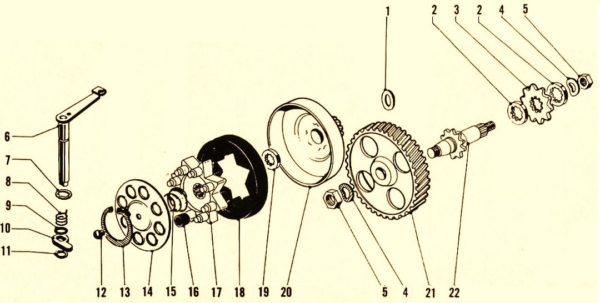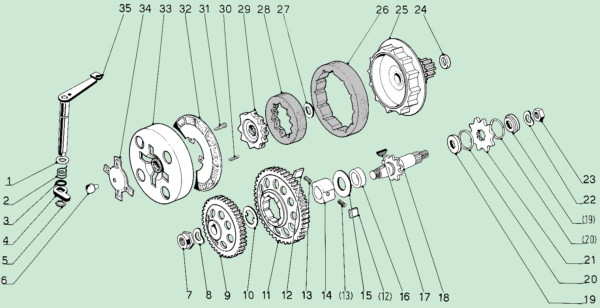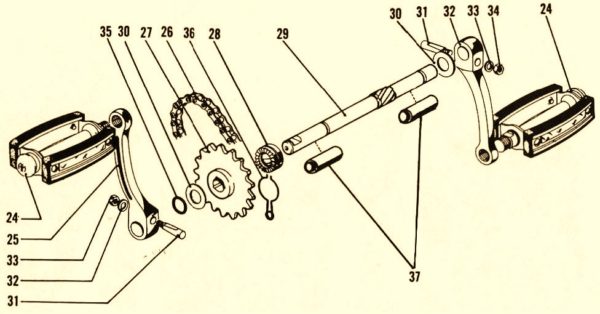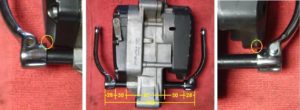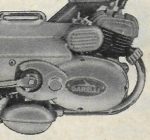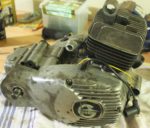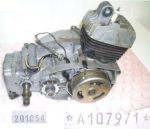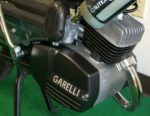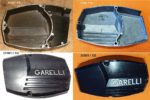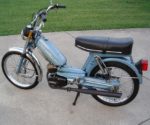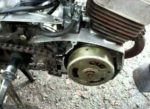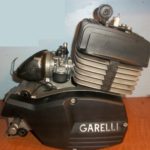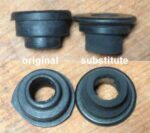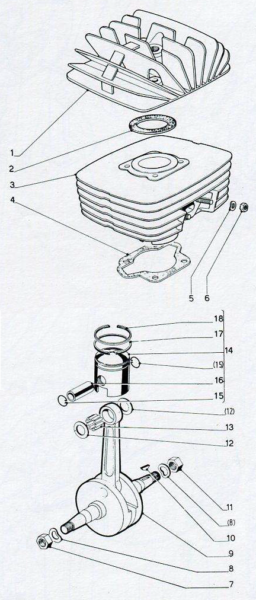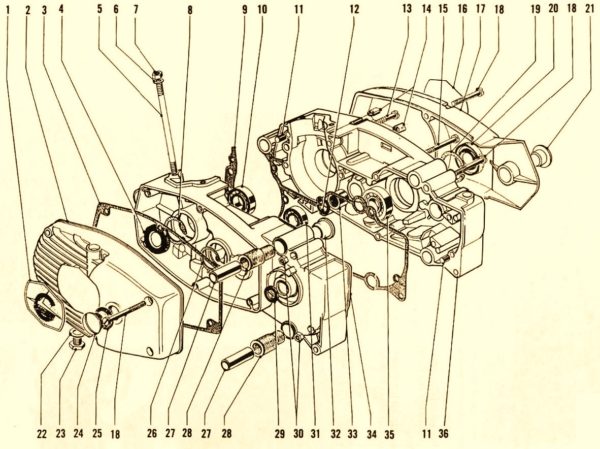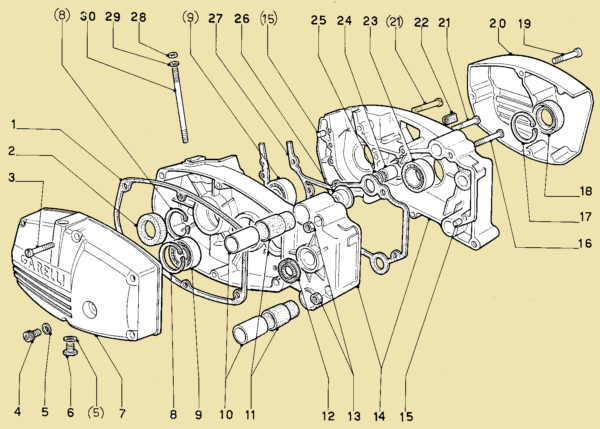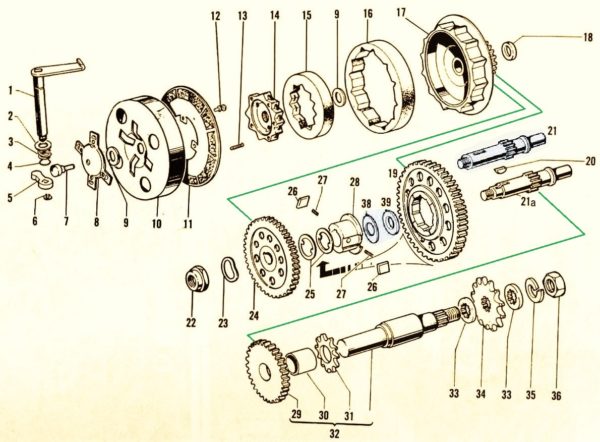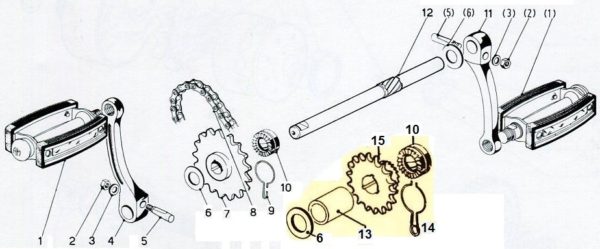Contents:
1. Horizontal-cylinder Engines
0 1970-86 1 speed automatic H1
0 1979-82 2 speed automatic H2
2. Vertical-cylinder Engines
0 1975-78 2 speed automatic G2
0 1978-86 2 speed automatic V2
0 1983-86 1 speed automatic M1
See Garelli Engines first to identify your engine model.
1. Horizontal-cylinder
1a. 1970-86 1-speed automatic H1
H1 or H2 gasket set $25 aftermarket
The head gasket aluminum ring is made to small,
It still works but does not stay stuck to the head.
# qty price part number A. H1 or H2 Top-End and Crankshaft
1a 1 N/A 205001.3.131 cylinder head radial F200001 to F201240
1b 1 N/A 205003.3.131 cylinder head 6-fin F201241 to F342161
1c 1 N/A 205002.3.131 cylinder head 12-fin F342162 to F360932
1d 1 N/A 205004.3.131 cylinder head 5-fin F360933 and above
2a 1 N/A 205051.3.232 ring gasket alum. 42-55.5 x 2.0 20-25-30
2b 1 N/A 205051.3.232 ring gasket alum. (same as 2a) 20-25mph
2b 1 $16.0 205001.3.232 ring gasket alum. 42-55.5 x 1.0 30mph
2c,d N/A 205051.3.232 ring gasket alum. (same as 2a) 20-25mph
2c 1 $10.0 205002.3.232 ring gasket alum. 42-55.5 x 1.5 30mph
2e 0 $4.00 treatland sub ring gasket alum. 42-54.0 x 0.4 fits loose!
2e 0 $5.00 treatland sub 54 OD does not stay centered in 55.5 hole
3a 1 N/A 205051.3.111 cylinder iron radial fins 20-25mph
3a 1 N/A 205001.3.111 cylinder iron radial fins 30 mph
3b 1 N/A 205060.3.111 cyl. iron 6-fin 20mph yellow dot
3b 1 N/A 205060.3.111 cyl. iron 6-fin 25mph yel. dot (to F275010)
3b 1 $190 205003.3.111 cyl. iron 6-fin 25mph red dot (F275011 on)
3b 1 N/A 205003.3.111 cyl. iron 6-fin 30mph red dot
3c 1 N/A 205054.3.111 cylinder aluminum 12-fin 20mph
3c 1 N/A 205002.3.111 cylinder aluminum 12-fin 25-30mph
3d 1 N/A 205059.3.111 cylinder aluminum 5-fin 20mph
3d 1 N/A 205004.3.111 cylinder aluminum 5-fin 25-30mph
4x 2 $0.20 00214.408.00 plain washer M6
5a,b $0.50 00132.319.00 hex bolt M6x20
5c,d $0.30 032315.7.596 nut M6
6x 1 N/A 00304.957.00 needle bearing Ø12-Ø16 x 14
6x 1 $15.0 00 135548 substitute bearing Ø12-Ø16 x 13
7x 1 $12.0 000351.2.191 piston pin Ø12 x 32.4
8x 2 $1.00 00275.312.00 piston pin clip Ø12
9x 1 $2.00 00273.511.00 flywheel key M80 2.0 x 2.8 x 6.9
10 1 $7.00 205001.3.231 base gasket
11 2 $10.0 00307.021.00 piston ring Ø40.0 x 2.0 FG side-pin standard
11 2 $15.0 00308.027.00 piston ring Ø40.2 x 2.0 FG side-pin 1st oversize
11 2 $12.0 00308.028.00 piston ring Ø40.4 x 2.0 FG side-pin 2nd oversize
12a,b N/A 205053.2.181 40.0 piston Ø39.93 18-12-17?25 mph (to F275010)
12 1 N/A 200001.2.181 40.0 piston Ø39.93 18-12-16 25 mph (F275011 on)
12 1 N/A 200001.2.181 40.0 piston Ø39.93 18-12-16 and 20 and 30 mph
12 1 $60.. 200001.subst 40.0 piston Ø39.94 18-12-16 std substitute
12 1 N/A 205053.2.184 40.2 piston Ø40.13 18-12-17?25 mph (to F275010)
12 1 N/A 200001.2.184 40.2 piston Ø40.13 18-12-16 25 mph (F275011 on)
12 1 N/A 200001.2.184 40.0 piston Ø40.1318-12-16 and 20 and 30 mph
12 1 N/A 205053.2.182 40.4 piston Ø40.33 18-12-17?25 mph (to F275010)
12 1 N/A 200001.2.182 40.4 piston Ø40.33 18-12-16 25 mph (F275011 on)
12 1 N/A 200001.2.182 40.0 piston Ø40.33 18-12-16 and 20 and 30 mph
12 1 $55.0 205053.2.152 40.4 piston Ø40.33 18-12-17 2os subst. GOL
12c,d N/A 205058.2.150 al-cyl piston 39.98? 18-12-?? 20-25mph
12a 1 N/A 205088.2.150 al-cyl piston 39.98? 18-12-?? 30mph
13 1 $5.00 000315.7.586 clutch nut H1 M12-1.0 x 7 hex19
13 1 $2.50 201001.2.917 clutch nut H2 M12-1.0 x 6 hex17 same as G2/V2
14 1 $1.50 00214.756.00 wave washer ∅12.2 ∅19.5 x 0.7
15 1 N/A 205001.2.100 crankshaft H1 early M8-1.0 fly. nut to F201240
15 1 N/A 205002.2.100 crankshaft H1 late M9-1.0 fly. nut F201241 & up
15 1 N/A 207302.2.100 crankshaft H2 (different left side, like G2/V2)
16 1 $0.30 00214.756.00 plain washer early Ø8 Ø14 to F201240
16 1 $1.50 000311.8.423 plain washer late Ø9 Ø14 F201241 and up
17a 1 N/A 000361.8.436 flywheel nut early M8-1 x 9 hex12 to F201240
17a $8.00 000361.8.436 substitute M8-1 x 6 hex12 & spacer ∅8 ∅12 x 3
17 1 N/A 205011.8.446 flywheel nut late M9-1 x 9 hex12 F201241 & up
17 1 $7.00 205011.8.446 substitute M9-1 x 9 hex 12
18a,b $37.0 205001.3.321 intake pipe ’72 rounded ∅18 clamp to F337644
18b,c,d N/A 205002.3.321 intake pipe ’80 angular ∅18 clamp F337645 on
19 1 $7.00 205001.3.311 intake gasket
# qty price part number B. H1 or H2 Engine Case
o1a 1 N/A 205002.1.110 left case half solid mount up to F201240
01 1 N/A 205003.1.110 left case half rubber mount F201241 & up
02 1 N/A 200001.1.195 clutch compartment vent
03 4 $0.60 00210.044.00 head nut M7-1.0
04 4 $0.20 000319.3.516 head washer ∅7
05 4 $5.00 205001.3.486 cylinder stud M7-1.0 x 103
06 2 $8.00 00298.681.00 L & R crank seal 17 x 30 x 6/6.5 F201241 & up
06 2 $8.00 0000 17x30x7 L & R crank seal 17 x 30 x 7 substitute
o6a 1 $7.50 00298.678.00 L crank seal early 17 x 30 x 5 up to F201240
o6a 1 none 00298.680.00 R crank seal early 15 x 30 x 6 up to F201240
o6a 1 $6.00 0015x30x5.5 substitute seal 15 x 30 x 5.5
o7a 1 N/A 205001.5.159 wires grommet up to F201240
07 1 N/A 205013.5.159 wires grommet F201241 & up
08 1 N/A 205013.1.132 magneto cover H1 only ’78 style black F271811 and up
09 1 N/A 205001.1.132 magneto cover H1 or H2 ’72 style silver up to F271810
09 1 N/A 205012.1.132 magneto cover H1 or H2 ’72 style black H038472 and up
10 10 $1.00 00152.396.00 slot screw M6 x 40 case (6) & mag cover (4)
11 1 N/A 205013.1.131 clutch cover H1 only ’78 style black F271811 and up
12 1 N/A 205002.1.131 clutch cover H1 or H2 ’72 style silver up to F271810
11 1 N/A 207056.1.131 clutch cover H1 or H2 ’72 style black H038472 and up
13 1 $14.0 205001.1.191 check and fill plug M12-1.5 x 10 original plastic, cracks easy
13 1 $6.00 M12-1.50-hex metal substitute M12-1.5 x 15 hex head sticks out 8-9 mm
14 1 N/A 0298.424.00 seal washer ∅12-∅17 x 2
14 1 $1.50 00298.424.00 substitute ∅12-∅17 x 1
15 4 $1.00 00152.392.00 slot screw H1 or H2 M6 x 35 clutch cover (4)
15 4 N/A 00152.400.00 slot screw H1 or H2 M6 x 45 clutch cover (4)
16 1 $6.00 250001.1.193 drain plug M10-1.25 x 15
17 1 N/A 00298.168.00 seal washer ∅10 ∅17 x 2
17 1 $1.50 00298.168.00 substitute ∅10 ∅17 x 1
18 1 N/A 205001.1.291 clutch cover gasket
19 4 $1.00 00152.412.00 slot screw M6 x 50(53) F case (2), R case (2)
20 6 N/A 205011.1.543 rubber tube ∅12-∅22 x 24 F201241 & up
21a 6 N/A 000315.1.364 metal tube ∅8.5-∅10 x ?? up to F201240
21 6 N/A 203002.1.544 metal tube ∅8.5-∅12 x 29 F201241 & up
22a 1 $9.00 205001.1.311 case gasket up to F201240
22 1 $9.00 205002.1.311 case gasket F201241 & up
23a 4 $10.0 00304.555.00 crank bearings #6303 ∅17 ∅35 x 10 up to F201240
23 4 $8.00 00302.058.00 crank bearings #6203C3 ∅17 ∅40 x 12 F201241 & up
24 1 $7.50 00298.678.00 drive shaft seal 17 x 30 x 5
24 1 $8.00 00017.030.07 substitute seal 17 x 30 x 7
25 2 $6.50 000315.1.364 dowel pin ∅7.97 x 12.0 F201241 & up
26a 1 N/A 205002.1.110 right case half solid mount up to F201240
26 1 N/A 205003.1.110 right case half rubber mount F201241 & up
27a 1 $3.00 205001.1.292 sprocket gasket, arch-with-2-holes up to F201240
28a 1 $6.00 205001.1.146 sprocket cover up to F201240
29a 2 $0.20 00213.828.00 washer ∅4 plain up to F201240
30a 2 $1.30 00171.711.00 screw M4 x 10 slot up to F201240
31 2 $1.00 00152.392.00 slot screw H1 M6 x 35 F clutch cover (2) silver
10 2 $1.00 00152.396.00 slot screw H2 M6 x 40 F clutch cover (2) silver
10 2 $0.80 00152.404.00 slot screw H1 or H2 M6 x 40 F clutch cover (2) black
32 1 N/A 203602.1.463 left sticker white 20mph up to F271810
32 1 N/A 200152.1.463 left sticker yellow 25mph up to F271810
32 1 N/A 203001.1.463 left sticker red 30mph up to F271810
33 1 N/A 203602.1.462 right sticker white 20mph up to F271810
33 1 N/A 200152.1.462 right sticker yellow 25mph up to F271810
33 1 N/A 203001.1.462 right sticker red 30mph up to F271810
# qty price part number C. H1 Clutch and Trans.
01 1 none.. 205003.7.122 plain washer ∅15.3 ∅24.0 x 2.75 F201241 and up
02 2 old# 000357.7.122 superseded to 207065.7.122
02 2 $8.00 207065.7.122 splined washer, sprocket ∅23 od x 3.0 (14 splines) same as 1.C.19 and 2.E.9
03 1 $19.0 205001.7.287 sprocket 10 tooth used
03 1 $15.0 aftermarket sprocket 11 tooth new, fits splines perfectly
04 2 $2.00 024357.7.587 wave washer for sprocket & gear ∅12 ∅23 x 1
05 2 $6.00 000315.7.586 nut for sprocket & gear M12-1.0 x 7 hex17
06 1 N/A 205002.7.061 start shaft-lever ∅9.9
07 1 $2.00 200001.7.826 shaft washer ∅10 ∅20 x 0.5
08 1 N/A 205002.7.195 shaft spring
09 1 N/A 00298.739.00 shaft o-ring ∅7 x 2.0 (11 od)
09 1 $2.00 00298.739.00 substitute ∅7.6 x 1.8 (11.2 od)
10 1 $12.0 205001.7.827 start lever
11 1 $1.50 00274.201.00 shaft circlip ∅9 for ∅10 shaft
12 1 $14.0 205001.7.821 start button-pin
13 1 $5.00 279.955.00 start large circlip ∅49 x 1.2
14 1 N/A 205001.7.828 start plate without button-pin #12
14 1 $59.0 205001.7assy start plate with button #12 installed
15 1 $4.50 024351.7.136 start spring conical coil ∅23.5 ∅21.5 x 22
16 6 N/A 010357.7.831 start bushing ∅7 ∅11 x 7
17 1 $27.0 205001.7.814 clutch hub star 1-speed
18 1 $33.0 002391.7.153 clutch rubber (elastic body)
19 1 $12.0 205001.7.122 splined washer, clutch ∅23 od x 3.0 (14 splines) same as 1.C.2 and 3.E.9
20a 1 $65.0 205001.7.016 drum w/gear 16T x 14.0, ∅15.0 up to F201240
20 1 $65.0 205002.7.016 drum w/gear 16T x 17.5, ∅15.0
21a 1 N/A 205003.7.112 main driven gear 71T ∅14.5 x 13 up to F201240
21 1 N/A 205004.7.112 main driven gear 71T ∅14.5 x 15
22a 1 $25.0 205003.7.261 drive shaft 9T, 98 mm up to F201240
22 1 N/A 205004.7.261 drive shaft 9T, 112 mm
# qty price part number D. H2 Clutch and Trans.
01 1 $2.00 200001.7.826 =H1 shaft washer ∅10 ∅20 x 0.5
02 1 N/A 205002.7.195 =H1 shaft spring
03 1 N/A 00298.739.00 =H1 shaft o-ring ∅7 x 2.0 (11 od)
03 1 $2.00 00298.739.00 substitute ∅7.6 x 1.8 (11.2 od)
04 1 $12.0 205001.7.827 =H1 start lever
05 1 $1.50 00274.201.00 =H1 shaft circlip ∅9 for ∅10 shaft
06 1 $14.0 205001.7.821 =H1 start button-pin ∅7 x 2.0 (11 od)
07 1 N/A 207303.7.586 =V2 special nut
08 1 N/A 207303.7.587 =V2 washer
09 1 N/A 207302.7.125 =H2 first gear driven H2
10 1 $8.00 00214.817.00 =G2 2-inner-tab washer
11 1 N/A 207302.7.018 =H2 second gear driven H2
12 2 $13.0 000357.7.185 =G2 ratchet pawl 13.7 x 11.9 x 2.4
13 2 N/A 000357.7.196 =G2 pawl spring cone ∅2.5 ∅4.0 x 7, wire 0.30, 5 turns
14 1 N/A 207302.7.131 =G2 ratchet hub body
15 1 N/A 00214.853.00 =G2 wave washer
16 1 N/A 207303.7.311 =G2 spacer
17 1 N/A 00271.036.00 =G2 woodruff key 4.0 x 6.5 x 15.4 M90
18 1 N/A 207002.7.261 =H2 drive shaft H2
19 2 N/A 207001.7.122 =H1 splined stepped washer 25mph use 207065
19 2 old# 000357.7.122 =H1 superseded to 207065.7.122
19 2 $8.00 207065.7.122 =H1 splined washer 30mph
20 2 N/A 00298.749.00 =H1 rubber square-ring 25mph optional
21 1 $19.0 205001.7.287 =H1 sprocket 10 tooth 25mph
21 1 N/A 205002.7.287 =H1 sprocket 11 tooth 30mph
22 1 $2.00 024357.7.587 =H1 washer, sprocket ∅12 ∅23 x 1
23 1 $6.00 000315.7.586 =H1 nut for sprocket M12-1.0 x 7 hex17
24 1 $7.00 205002.7.122 =V2 plain washer ∅15.3 ∅23.9 x 2.0
25 1 $75.0 207302.7.016 =H2 driving gear assembly H2
26 1 $20.0 000357.7.158 =G2 elastic body second speed
27 1 old# 000357.7.122 =H1 superseded to 207065.7.122
27 1 $8.00 207065.7.122 =H1 splined washer ∅15.1 ∅23.0 x 3.0, 14 splines
28 1 $21.0 000357.7.153 =G2 elastic body first speed
29 1 $33.0 024357.7.814 =G2 clutch hub center star 2-speed
30 5 $4.00 207051.7.357 =G2 start clutch coil spring ∅5.5 x 17.8
31 4 $2.50 024357.7.829 =G2 rubber grommet-rivet
32 1 N/A 024357.7.833 =G2 start clutch plate
33 1 N/A 201001.7.028 =G2 clutch drum
34 1 N/A 024357.7.834 =G2 start push plate plus-shape
35 1 N/A 205002.7.061 =H1 start shaft-lever ∅9.9
Only 4 parts (the driving gear assembly, both driven gears, and the driveshaft) in the H2 transmission are specific to H2. The other 31 parts are shared with H1, G2 and V2 engines.
# qty price part number E. H1 or H2 Pedal parts
24 1 N/A 000.216.0631 set of pedals original classic metal with 2 curved rubber blocks
24 1 $15.0 000.00.41124 substitute pedal set, classic metal with 2 straight rubber blocks
25a 1 N/A 000.223.0783=1190 left arm 6½” 5½” reach 1½” offset 536L w/ groove Eureka up to F201240
25 1 N/A 000.227.0783 left pedal arm 6¾” 5¾” reach 1″? offset oo00 no groove Eureka F201241 & up
25 1 N/A 000.225.0783 left pedal arm 6¾” 5¾” reach 1¼” offset 603L no groove Sport and other H1, H2
25 1 $17.0 000.000 613L left pedal arm 7¼” 6¼” reach 1½” offset 613L repro beautiful chrome ½” longer
25 1 $20.0 000.000 513L left pedal arm 6¼” 5¼” reach ¾” offset 513L repro beautiful chrome ½” shorter
25 1 (cont.) 00000 (cont.) has a 9.5 mm pin hole but requires a 9.0 mm wedge pin
25+32$28.0 0000. set-613 pedal arm set 7¼” 6¼” reach 1½” offset 613 crank arm set 613L and 613R
25+32$35.0 0000. set-513 pedal arm set 6¼” 5¼” reach ¾” offset 513 crank arm set 513L and 513R
26 1 $14.0 205001.7.070 pedal chain “Regina 7SA35” #35 x 34 link
27 1 N/A 205002.7.421 pedal sprocket 27 tooth #35
28 1 N/A 203001.7.441 toothed clamp (ratchet block)
29 1 $38.0 205003.7.427 pedal shaft length 232 mm
30 2 none.. 200001.7.187 washer ∅16.2 ∅32 x 2.0
31 2 $2.00 000.000.2074 wedge pin 9.0 ∅9.0 for #513 and cranks from Italy, Spain, France mostly
31 2 $2.00 000.00wp-9.5 wedge pin 9.5 ∅9.5 for #613 and cranks from Germany, Taiwan, others
32a 1 $24.0 000.010.0785=1250 right arm 6¾” 5¾ reach ¾” offset 536R w/ groove Eureka up to F201240
32 1 N/A 000.214.0785 right pedal arm 6¾” 5¾” reach ¾”? offset 0000 no groove Eureka F201241 & up
32 1 $23.0 000.221.0782 right pedal arm 6¾” 5¾” reach ½” offset 604R no groove Sport and other H1, H2
32 1 $12.0 000.000 613R right pedal arm 7¼” 6¼” reach 1½” offset 613R repro beautiful chrome ½” longer
32 1 (cont.) 00000 (cont.) requires 2mm sliced off the right 52mm protection tube
32 1 $17.0 000.000 513R right pedal arm 6¼” 5¼” reach ¾” offset 513R repro beautiful chrome ½” shorter
32 1 (cont.) 00000 (cont.) has a 9.5 mm pin hole but requires a 9.0 mm wedge pin
33 2 $0.20 000.000.2064 wedge pin washer ∅6
34 2 $0.30 00210.039.00 wedge pin nut M6
35 2 N/A 00299.809.00 square ring ∅16 ∅20 x 2.5
35 2 $2.00 O16x20x2ring substitute ∅16 ∅20 x 2.0
36 1 $9.00 200001.7.444 ratchet spring
37 2 N/A 506651.7.618 protection tube right ∅16 ∅18 x 52
37 2 N/A 506701.7.618 protection tube left ∅16 ∅18 x 30
2. Vertical Cylinder
2a. 1975-78 2-speed automatic G2
a. A000001 to A099999 =00000, ≈1970-75? pre-US, G1 and G2
b. A100001 to A102114 =02114, ≈1976-77? early gear-shift ratchet
b. eng# A102115 and up=ooooo, ≈1977?-78 late gear-shift ratchet
V.I.P. vertical-cylinder 2-speed automatic “V2”
c. A150001 to A177887 =27887, ≈1978-80, 1978 mag cover #1, CEV 2158 “bullet” headlight
c. A177888 to A181000? =3112? ≈1980-84, 1980 mag cover #2, CEV 1211 “pancake” headlight
d. eng A200000? and up =oooo, ≈1984-86, center carburetor, CEV 1233.1 “Euro” headlight
Monza GT vertical-cylinder 1-speed automatic “M1”
e. B344619 and above (1983-84) radial silver head fins, mag cover #3
f. L0????? and above (1984-86) square black head fins, mag cover #3
# qty price part number A. G2 or V2 Top End
1a 1 N/A 200001.3.131 cylinder head early
1x 1 N/A 200001.3.131 cylinder head
2x 2 N/A 000912.1.543 rubber bushing 3-step id ∅11.4 x 16.5
2x 2 (cont.) 000912.1.543 od=15.5 x 6, od=22.5 x 7, od=26 x 4
2x 2 $12.0 000912.1.543 rubber bushing substitute id 11.0 x 16
2x 2 (cont.) 000912.1.543 od=15.3 x 6, 0d=21.9 x 7, od=27 x 3
3a 1 $7.00 000912.1.157 metal tube early ∅8.5 ∅11/10 x 32
3x 1 $9.00 000912.1.157 metal tube straight ∅8.5 ∅11 x 32
4a 1 N/A 200001.3.232 head gasket early, square type
4x 1 $10.0 200001.3.232 ring gasket aluminum ∅42 ∅57.3 x 1.0
5x 2 $1.00 00275.312.00 piston pin clip Ø12
6x 1 $12.0 000351.2.191 piston pin Ø12 x 32.4
7x 1 N/A 205053.2.150 40.0 piston Ø39.93 18-12-17? 25mph
07 1 N/A 205053.2.151 40.2 piston Ø40.13 18-12-17? 1st oversize
07 1 $55.0 205053.2.152 40.4 piston Ø40.33 18-12-17 2nd o.s. GOL
07 1 N/A 200001.2.150 40.0 piston Ø39.93 18-12-16 30mph
07 1 N/A 200001.2.151 40.2 piston Ø40.13 18-12-16 1st oversize
07 1 N/A 200001.2.152 40.4 piston Ø40.33 18-12-16 2nd oversize
8x 2 $10.0 00307.021.00 piston ring Ø40.0 x 2.0 FG side-pin std
8x 2 $15.0 00308.027.00 piston ring Ø40.2 x 2.0 FG side-pin 1 o.s
8x 2 $12.0 00308.028.00 piston ring Ø40.4 x 2.0 FG side-pin 2 o.s
9a 1 N/A 200001.3.111 cylinder iron Gulp early
9b 1 N/A 200052.3.111 cylinder iron G2, slanted transfers 25mph
9b 1 $180 200001.3.111 cylinder iron G2, slanted transfers 30mph
9c 1 N/A 200002.3.111 cylinder iron V2, straight transfers 25-30
10 1 $12.0 203001.3.231 base gasket G2, slanted transfers type
10c $8.00 211001.3.231 base gasket V2, straight transfers type
11 2 $0.20 00214.409.00 plain washer M6
12 2 $0.50 00171.706.00 hex bolt M6x20
13 1 N/A 00304.957.00 needle bearing Ø12-Ø16 x 14
13 1 $15.0 00 135548 substitute bearing Ø12-Ø16 x 13
14 1 $2.50 201001.2.917 clutch nut M12-1.0 x 6 hex17
15 1 $1.50 00214.756.00 wave washer ∅12.2 ∅19.5 x 0.7
16 1 N/A 201001.2.100 crankshaft G2, pork chop type
16 1 N/A 212001.2.100 crankshaft V2, pork chop to-’80 78mm L
16 1 $140 212001.2.100 crankshaft V2, full circle ’80-on 78mm L
17 1 $4.50 00271.018.00 flywheel key M83 2.5 x 3.0 x 9.0
18 1 $1.50 000311.8.423 wave washer Ø10
19 1 $7.00 000315.8.446 flywheel nut M10-1.0 x 14 hex14
20 1 N/A 000315.3.233 exhaust gasket ring ∅24 ∅32.5 x 2.5
20 1 $2.50 W62-24-32-2 substitute gasket ring ∅24 ∅32 x 2.0
21 1 $7.00 032315.3.322 intake gasket
22 1 N/A 043351.3.321 intake pipe ∅18 clamp
# qty price part number B. M1 Top End
1a 1 N/A 203664.3.131 cylinder head silver radial fins
1b 1 N/A 203664.3.131 cylinder head black square fins
2x 1 N/A 200056.3.232 ring gasket aluminum 25mph thicker
2x 1 N/A 200052.3.232 ring gasket aluminum 30mph
3x 1 N/A 208051.3.111 cylinder, all aluminum, piston port
4x 1 $8.00 211001.3.231 base gasket V2 & M1
5x 2 $0.20 00214.408.00 plain washer M6
6x 2 $0.30 032315.7.596 nut M6
7x 1 N/A 000357.2.917 clutch nut M1 M12-1.0 x ??
8x 1 $1.50 00214.756.00 wave washer for clutch ∅12.2 ∅19.5 x 0.7
(8) 1 $1.50 000311.8.423 wave washer for magneto Ø10 ∅16? x 1.0?
9x 1 N/A 200062.2.100 crankshaft M1 full circle type
10 1 $4.50 00271.018.00 flywheel key M83 2.5 x 3.0 x 9.0
11 1 $7.00 000315.8.446 flywheel nut M10-1.0 x 14 hex14
12 2 N/A not delivered older version shown, new version is 1-piece
13 1 N/A 00304.957.00 needle bearing Ø12-Ø16 x 14
13 1 $15.0 00 135548 substitute bearing Ø12-Ø16 x 13
14 1 N/A 208703.2.150 piston M1 ∅39.9x, 22-12-16 with window
15 2 $1.00 00275.312.00 piston pin clip Ø12
16 1 $12.0 000351.2.191 piston pin Ø12 x 32.4
17 1 $10.0 00307.181.00 piston ring lower Ø40 x 1.5 FG side pin
18 1 $10.0 00310.001.00 piston ring upper L-type Ø40 x 2.0 Dykes type
19 2 N/A 208604.3.229 rubber comb vibration damper for cyl fins
The Monza GT piston has a very high top, 22mm from the edge of the pin to the edge of the top dome. Most Garelli moped pistons are 18mm, pin to top. This is like early 1970’s Garelli European models such as Tiger, but with a boost transfer port rectangular window on the upper intake side of the piston. Apparently a Tiger piston, without the transfer port window, works in a Monza GT, but makes less power.
The piston shown in the illustration does not have a boost window, like a Monza GT piston has.
# qty price part number C. G2 Case
01 1 N/A 201001.1.463 left side decal 25mph
01 1 N/A 203602.1.463 left side decal 30mph
02 1 $75.0 200001.1.131 left (clutch) cover
03 1 $7.00 203001.1.291 clutch cover gasket Gulp
04 2 $9.50 00298.585.00 crank seal L and R 17-40-8.5 1-lip
04 2 $9.00 00 17x40x7TC substitute-upgrade 17-40-7TC 2-lip
05 4 $5.00 000351.3.486 cylinder stud M7 x 113
06 4 $0.20 000319.3.516 head washer ∅7
07 4 $0.60 00210.044.00 head nut M7-1.0
08 2 N/A 000315.1.377 circlip internal type 40 x 1.7
09 1 $8.00 203001.1.311 case gasket Gulp
10 2 $8.00 00302.058.00 crank bearing L & R #6203C3 ∅17 ∅40 x 12
11 2 $6.50 000315.1.364 dowel pin ∅7.97 x 12.0
12 1 N/A 00214.825.00 washer
13 6 $1.00 00152.392.00 slot screw, front case 6 M6 x 35
14a 1 N/A 200001.5.159 top rubber grommet (for internal spark coil magneto) ∅5 hole for thick spark wire
14a 1 N/A 200001.5.159 back rubber grommet (for internal spark coil magneto) ∅5 hole for 2 output wires
14 1 N/A 203003.5.159 top rubber grommet (for external spark coil magneto) no hole
14 1 N/A 200001.5.159 back rubber grommet (for external spark coil magneto) ∅5 hole for 3 output wires
15 3 $0.80 00152.240.00 slot screw, mid clutch cover 2, mid case upper 1 M6 x 60
15 2 $2.00 00155.448.00 slot screw, front clutch cover 2 M6 x 60 with seal washer
16 1 N/A 201001.1.462 right side decal 25mph
01 1 N/A 203602.1.462 right side decal 30mph
17 1 N/A 203001.1.132 right (magneto) cover
18 8 $1.00 00152.400.00 slot screw, mag cover 3, rear clutch cover 2, rear case 2, mid case lower 1 M6 x 45
19 1 $5.00 00274.030.00 circlip internal type 42 x 1.7
20 1 $8.00 00298.603.00 sprocket shaft seal 20-42-7 1-lip
20 1 $8.00 00 20x42x7TC substitute-upgrade 20-42-7TC 2-lip
22 1 $1.50 00298.424.00 drain plug seal washer ∅12-∅18 x 1.5
23 1 $12.0 000315.1.193 drain plug M12-1.50 x 11, hex 17 x 5
24a N/A 205001.1.191 check and fill plug early big type
24 1 $14.0 205001.1.191 check and fill plug M12-1.5 x 10 original plastic, cracks easy
24 1 $6.00 M12-1.50-hex metal substitute M12-1.5 x 15 hex head sticks out 8-9 mm
25 1 $1.50 00298.424.00 seal washer ∅12-∅17 x 2
26 1 N/A 00274.024.00 circlip internal type ?? x ??
27 2 $8.00 203002.1.547 metal tube ∅8.5 ∅12 x 46
28 2 $14.0 203001.1.546 rubber bushing 3-step id=12.5, length=43
28 2 (cont.) 203001.1.546 od=15 x 15, od=20 x 27, od=24 x 1
29 2 $5.00 00298.671.00 pedal shaft seal 16 x 24 x 4 1-lip
04 2 $7.00 00 16x24x4TC subst.-upgrade 16 x 24 x 4TC 2-lip
30 2 $0.30 00210.416.00 nut M6
31 1 $19.0 00304.555.00 main shaft left bearing #16003 ∅17 ∅35 x 8
32 1 $23.0 211001.1.237 bronze bushing 1-step ∅20 ∅25 ∅28 x 13.7
33 1 $8.00 00304.955.00 needle bearing ∅13 ∅19 x 12 HK1312
34 1 N/A 200003.1.110 left case half (R & L set)
35 1 $16.0 00304.557.00 bearing #16004 ∅20 ∅42 x 8
36 1 N/A 200003.1.110 right case half (R & L set)
# qty price part number D. V2 or M1 Case
01 1 $8.00 211001.1.291 clutch cover gasket VIP
02 1 $7.00 00298.682.00 crank seal right 17 x 40 x 7
02 1 $7.00 00298.683.00 crank seal left 17 x 40 x 7
03 6 $0.80 00152.240.00 slot screw V2 M6 x 60
03 6 N/A 00152.375.00 slot screw M1 M6 x 55
04 1 $14.0 205001.1.191 check and fill plug M12-1.5 x 10 original plastic, cracks easy
04 1 $6.00 M12-1.50-hex metal substitute M12-1.5 x 15 hex head sticks out 8-9 mm
05 2 $1.50 00298.424.00 seal washer ∅12-∅17 x 1
06 1 $12.0 000315.1.193 drain plug M12-1.50 x 11 hex 17×5
07 1 N/A 211001.1.131 clutch cover #1 M1
07 1 N/A 212001.1.131 clutch cover #2 V2
08 3 N/A 000315.1.377 circlip internal type 40 x 1.7
09 3 $8.00 00302.058.00 crank & main shaft bearing #6203C3 ∅17 ∅40 x 12
10 2 $8.00 203002.1.547 metal tube ∅8.5 ∅12 x 46
11 2 $14.0 203001.1.546 rubber bushing 3-step id=12.5, length=43
28 2 (cont.) 203001.1.546 od=15 x 15, od=20 x 27, od=24 x 1
12 2 $5.00 00298.671.00 pedal shaft seal 16 x 24 x 4 1-lip
12 2 $7.00 00 16x24x4TC subst.-upgrade 16 x 24 x 4TC 2-lip
13 2 $0.30 00210.416.00 case nut M6
14 1 N/A 211001.1.110 left and right case set V2
14 1 N/A 201068.1.110 left and right case set M1
15 2 $6.50 000315.1.364 dowel pin ∅7.97 x 12.0
16 4 $0.80 00152.375.00 slot screw M6 x 55
17 1 $5.00 00274.030.00 circlip internal type 42 x 1.7
18 1 $8.00 00298.603.00 sprocket shaft seal 17-42-7 1-lip
18 1 $8.00 00 20x42x7TC substitute-upgrade 17-42-7TC 2-lip
19 3 $1.00 00152.400.00 slot screw M6 x 45
20 1 $34.0 211001.1.132 magneto cover #1 V2 to A177887
20 1 N/A 212001.1.132 magneto cover #2 V2 A177888 & up
20 1 N/A 213001.1.132 magneto cover #3 M1
21 6 $1.00 00152.392.00 slot screw, front case 6 M6 x 35
22 1 N/A 200001.5.159 rubber grommet (for external spark coil magneto) ∅5 hole for 3 output wires
23 1 $16.0 00304.557.00 ball bearing ∅20 ∅42 x 8 #16004
24 1 $8.00 00304.955.00 needle bearing ∅13 ∅19 x 12 HK1312
25 1 N/A 00214.825.00 washer ∅13
26 1 $18.0 211001.1.237 bronze bushing 1-step ∅20 ∅24 ∅28 x 13
27 1 $8.00 211001.1.311 case gasket VIP
28 4 $0.60 00210.044.00 head nut M7-1.0
28 4 N/A 046353.3.494 head nut M7-1.0 tall?
29 4 $0.20 000319.3.516 head washer ∅7
30 4 $5.00 000351.3.486 cylinder stud M7 x 113
30 4 N/A 044354.3.486 cylinder stud M1 M7 x ??
# qty price part number E. G2 or V2 Transmission
01 1 N/A 200001.7.061 =G2 start shaft with lever
02 1 $2.00 200001.7.826 =H1 shaft washer ∅10 ∅20 x 0.5
03 1 N/A 205002.7.195 =H1 shaft spring
04 1 N/A 00298.739.00 =H1 shaft o-ring ∅7 x 2.0 (11 od)
04 1 $2.00 00298.739.00 substitute ∅7.6 x 1.8 (11.2 od)
05 1 N/A 200001.7.827 =G2 start lever G2
05 1 N/A 205001.7.827 =H1 start lever V2
06 1 $1.50 00274.201.00 =H1 shaft circlip ∅9 for ∅10 shaft
07 1 $10.0 205001.7.821 =H1 start button pin
08 1 $24.0 024357.7.834 =G2 start push plate “+” shape without center button-pin
08 1 $38.0 00 #8 and #7 =G2 start push plate “+” with center button-pin installed
09 1 $12.0 000351.7.122 =G2 splined washer G2 ∅15.1 ∅23.0 x 3.0 (14 splines) same as 1.C.2 and 1.C.19
09 1 (cont.) 000351.7.122 =G2 a second #9 is shown before #10, but it is actually part of #10
09 1 $7.00 201351.7.122 =V2 plain washer V2 ∅15.3 ∅24.0 x 3.0
10 1 N/A 201001.7.028 =G2 clutch drum
11 1 N/A 024357.7.833 =G2 start clutch plate
12 4 $2.50 024357.7.829 =G2 rubber grommet-rivet
13 5 $3.00 207051.7.357 =G2 start clutch coil spring ∅5.5 x 17.8
14 1 $33.0 024357.7.814 =G2 clutch hub center star 2-speed
15 1 $24.0 000357.7.153 =G2 elastic body first speed
16 1 $22.0 000357.7.158 =G2 elastic body second speed
17 1 $55.0 024357.7.016 =G2 outer star with driving gears assembly
18 1 $7.00 201351.7.122 =G2 washer G2 ∅15.3 ∅24.0 x 3.0
18 1 $7.00 205002.7.122 =V2 washer V2 ∅15.3 ∅23.9 x 2.0
19 1 N/A 024357.7.018 =G2 first speed driven gear G2
19 1 N/A 212001.7.018 =V2 first speed driven gear V2
20 1 N/A 00271.036.00 =G2 woodruff key 4.0 x 6.5 x 15.4 M90
21a 1 N/A 201001.7.261 =G2 main shaft G2 with final driving gear 14T
21 1 N/A 212001.7.261 =V2 main shaft V2 with final driving gear 14T
22 1 N/A 024357.7.586 =G2 special nut G2
22 1 N/A 207303.7.586 =V2 special nut V2
23 1 $2.00 024357.7.587 =H1 washer for gear ∅12 ∅23 x 1
24 1 N/A 024357.7.125 =G2 second speed driven gear G2
24 1 N/A 212001.7.125 =V2 second speed driven gear V2
25 2 $8.00 00214.817.00 =G2 2-inner-tab washer up to A102114
25 1 $8.00 00214.817.00 =G2 2-inner-tab washer A102115 & up
26 2 $13.0 000357.7.185 =G2 ratchet pawl 13.7 x 11.9 x 2.4
27 2 N/A 000357.7.196 =G2 pawl spring cone ∅2.5 ∅4.0 x 7, wire 0.30, 5 turns
28 1 N/A 201001.7.131 =G2 ratchet hub body up to A102114
28 1 $25.0 201002.7.131 =G2 ratchet hub body A102115 & up
29 1 N/A 201002.7.283 =G2 final driven gear G2
29 1 N/A 211001.7.283 =V2 final driven gear V2
30 1 N/A 201002.7.423 =G2 spacer G2
31 1 N/A 202001.7.421 =G2 pedal chain sprocket G2 #35 11T
32 1 N/A 201002.7.200 =G2 driveshaft G2 with 29, 30, 31 length = 133 mm
32 1 N/A 211001.7.200 =V2 driveshaft V2 w/29 (30,31 9T permanent) L = ??
33 2 $8.00 203654.7.286 =G2 splined washer ∅19.2 ∅26.5 x 4.0 (18 splines)
34 1 N/A 203001.7.287 =V2 sprocket 12 tooth 25mph
34 1 $19.0 201001.7.287 =V2 sprocket 13 tooth 30mph
35 1 $1.50 00213.672.00 =G2 split washer ∅15 ∅24 x 3
36 1 N/A 200001.7.422 =G2 sprocket nut M14-1.0 x 10 22hex
36 1 $2.50 200001.7.422 =G2 substitute nut M14-1.0 x 7 19hex
38 1 $10.0 00214.853.00 =G2 washer ∅17.3 ∅42.8 x 2.0 only on A102115 & up
39 1 N/A 201002.7.311 =G2 spacer only on A102115 & up
The additional primary shaft changes the direction of rotation. So the G2, V2, and M1 engines rotate in the opposite direction as H1 and H2. Looking at the flywheel from the right side, G2, V2 and M1 rotate clockwise (CEV 6939 magneto with M18 “left hand” points) while H1 and H2 rotate anti-clockwise (CEV 6933 magneto with M14 “right hand” points).
# qty price part number F. M1 Transmission
01 1 N/A 200001.7.061 =G2 start shaft with lever
02 1 $2.00 200001.7.826 =H1 shaft washer ∅10 ∅20 x 0.5
03 1 N/A 200001.7.195 =00 shaft spring M1
04 1 N/A 00298.739.00 =H1 shaft o-ring ∅7 x 2.0 (11 od)
04 1 $2.00 00298.739.00 substitute ∅7.6 x 1.8 (11.2 od)
05 1 $12.0 205001.7.827 =H1 start lever
06 1 $1.50 00274.201.00 =H1 shaft circlip ∅9 for ∅10 shaft
07 2 $6.00 000315.7.586 =H1 nut xx for gear M12-1.0 x 7 hex17
08 2 $2.00 024357.7.587 =H1 washer for gear ∅12 ∅23 x 1
09 1 N/A 211001.7.112 =00 main driven gear M1
10 1 N/A 211001.7.261 =00 main shaft M1 with final driving gear 14T
11 1 N/A 211001.7.200 =00 drive shaft M1
12 1 N/A 211001.7.261 =00 final driven gear M1
13 2 $8.00 203654.7.286 =G2 splined washer ∅19.2 ∅26.5 x 4.0 (18 splines)
14 1 N/A 206052.7.287 =V2 sprocket 16 tooth 25mph
14 1 N/A 200001.7.287 =V2 sprocket 17 tooth 30mph
15 1 $1.50 00213.672.00 =G2 split washer ∅15 ∅24 x 3
16 1 N/A 200001.7.422 =G2 sprocket nut M14-1.0 x 10 22hex
16 1 $2.50 200001.7.422 =G2 substitute nut M14-1.0 x 7 19hex
17 1 $7.00 205002.7.122 =H1 washer, clutch inner ∅15.3 ∅23.9 x 2.0
18 1 N/A 211001.7.016 =00 clutch drum M1 with main driving gear
19 1 old# 000357.7.122 =H1 superseded to 207065.7.122
19 1 $8.00 207065.7.122 =H1 splined washer, clutch inner
20 1 $29.0 205001.7.814 =H1 clutch hub star
21 1 $4.50 024351.7.136 =H1 start spring ∅23 x 22
22 6 N/A 010357.7.831 =H1 start bushing ∅7 ∅11 x 7
23 1 $33.0 002391.7.153 =H1 clutch rubber (elastic body)
24 1 $35.0 205001.7.828 =H1 start plate without button
24 1 $49.0 205001.7assy =H1 start plate with button #26
25 1 N/A 00279.955.00 =H1 start large circlip ∅49 x 1.2
26 1 $14.0 205001.7.821 =H1 start button-pin
# qty price part number G. G2, V2 or M1 Pedal parts
01 1 N/A 000.000.0631 set of pedals G2 & V2 metal, curved rubber blocks
01 1 N/A 000.212.0681 set of pedals M1 all-black solid rubber block type
01 1 $15.0 000.00.41124 substitute pedals metal, two straight rubber blocks
02 2 $0.30 00210.039.00 wedge pin nut M6
03 2 $0.20 000.000.2064 wedge pin washer ∅6
04 1 N/A 000.200.0783=8920 left crank 6¾” 5¾” reach 1½” offset 0000 G2
04 1 N/A 000.225.0783 left pedal crank 6¾” 5¾” reach 1¼” offset 0000 V2
04 1 N/A 000.000.0857 left pedal crank 6¾” 5¾” reach 1¼” offset 0000 M1
04 1 $17.0 000.000 613L left pedal crank 7¼” 6¼” reach 1½” offset 613L repro beautiful chrome
05 2 $2.00 000.000.2074 wedge pin with nut 9.0 mm
06 2 none.. 200001.7.187 washer ∅16 ∅32 x 2.0
07 1 $21.0 211001.7.429 pedal sprocket V2 17 tooth #35
08 1 $14.0 200001.7.070 pedal chain G2 says “Regina ASA35” #35 x 28 link
08 1 $14.0 211001.7.070 pedal chain V2 says “Regina ASA35” #35 x 26 link
09 1 $9.00 200001.7.444 ratchet spring
10 1 N/A 200001.7.441 toothed clamp (ratchet block)
11 1 $22.0 000.211.0782=8930 right crank 6¾” 5¾” reach 1¼” offset 539R G2
11 1 N/A 000.206.0782 right pedal crank 6¾” 5¾” reach 1″? offset 0000 V2 up to frame SA07026
11 1 $20.0 000.223.0782 right pedal crank 6¾” 5¾” reach ¾” offset 604R V2 frame SA07027 & up
11 1 N/A 000.000.0856 right pedal crank 6¾” 5¾” reach ¾” offset 0000 M1
11 1 $12.0 000.000 613R right pedal crank 7¼” 6¼” reach 1½” offset 613R repro beautiful chrome
12 1 N/A 200001.7.427 pedal shaft G2 233 mm total length
12 1 N/A 211001.7.427 pedal shaft V2 225 mm total length up to engine# A177887
12 1 N/A 200058.7.427 pedal shaft M1 and V2 right 15? longer eng# A177888 & up
13 1 N/A 200001.7.437 spacer G2 only ∅16.4 ∅24 x 29.5
14 1 $9.00 200001.7.444 ratchet spring, same part # as item 9
15 1 N/A 200001.7.429 pedal sprocket G2 19 tooth
16 1 N/A 502151.7.618 left protection tube V2 ∅16 ∅18 x 47 up to A177887
16 1 N/A 500225.7.618 right protection tube V2 ∅16 ∅18 x 32 up to A177887
16 2 N/A 502151.7.618 L & R protection tube V2 ∅16 ∅18 x 47 A177888 & up
Here are illustrations, measurements, and more info, by Garelli Guru Yugi Trall
Gulp/VIP Differences: https://www.mopedarmy.com/forums/read.php?2,4279212
Garelli Crankshafts: https://www.mopedarmy.com/forums/read.php?1,4279937
Engine Hardware Parts, listed by type
Garelli precision washers
000 part # 00 price 00 I.D 0 O.D thickness description oo applications
200001.7.187 none.. ∅16.2 ∅32.0 x 2.0 , no splines H1-H2-G2-V2-M1 pedal
205002.7.122 $7.00 ∅15.3 ∅23.9 x 2.0 , no splines H2-V2-M1 clutch inner
201351.7.122 $7.00 ∅15.3 ∅24.0 x 3.0 , no splines G2 clutch inner
205003.7.122 none.. ∅15.3 ∅24.0 x 2.75 no splines H1 clutch inner
2
Garelli splined washers
000 part # 00 price 00 I.D 0 O.D thickness description oo applications
000357.7.122 old# superseded to 207065.7.122
207065.7.122 $8.00 ∅15.1 ∅23.0 x 3.0, 14 splines H2-M1 clutch, H1 sprocket
000351.7.122 $12.0 ∅15.1 ∅23.0 x 3.0, 14 machined G2 clutch use 207065.7.122
205001.7.122 none.. ∅15.1 ∅22.1 x 3.0, 14 splines H1 clutch use 207065.7.122
203654.7.286 $8.00 ∅19.2 ∅26.5 x 4.0, 18 splines G2-V2-M1 sprocket
Garelli engine screws: head type is called “cheese slot”
00152.240.00 $0.80 slot screw M6 x 60
00152.375.00 $0.80 slot screw M6 x 55
00152.392.00 $1.00 slot screw M6 x 35
00152.396.00 $1.00 slot screw M6 x 40
00152.400.00 $1.00 slot screw M6 x 45
00152.404.00 $0.80 slot screw M6 x 40 black?
00152.412.00 $0.80 slot screw M6 x 50(53 actual)
00155.448.00 N/A slot screw M6 x 60 with seal washer
